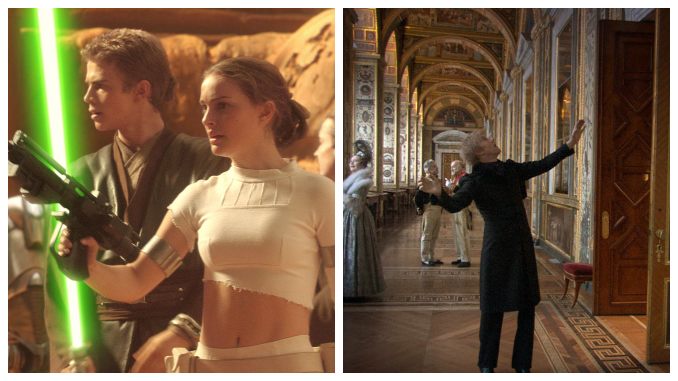Star Wars, Russian Ark and Cinema’s Digital Revolution

Twenty years ago at the 55th Cannes Film Festival, cinema entered the digital era. Two films present at the festival, not just shot but projected digitally, acted as landmarks for the coming age, both exploring the never-before-possible capabilities of this new cinema technology. One was a Russian arthouse film. The other, an American franchise blockbuster. One reached for the raw, untampered unfolding of time. The other worked on the complete construction of the image from atomized movie bits. Russian Ark and Star Wars: Episode II—Attack of the Clones exist on the extreme ends of two wildly different directions that film aesthetics can reach towards. They are part of an argument as old as the medium itself and, wielding the same Sony camera, they launched that dialogue into the 21st century.
Two summers earlier, George Lucas had returned to the deserts of Tunisia familiar to him from his first young and reckless attempt at making a sci-fi fantasy film. He didn’t come with 35mm cameras this time. Now he was armed with something new: A high-definition, cinema-grade digital camera. The Sony HDW-900 was a powerful machine, capable of shooting at 24fps in 1080p, as opposed to the conventional 30fps interlaced images that had been conventional for television and consumer-grade cameras for decades. Gone was the artifacting so specific to analog digital; here was a camera that created images that were directly comparable to that of photochemical film. Their rig was still bulky, however, needing massive, high-performance Panavision lenses to cleanly expose the tiny digital sensor. In a making-of documentary for Clones, Victor Kemper, the then-president of the American Society of Cinematographers, said, “We spent years in the film industry trying to get the camera free. Now suddenly we’re tied to cables again.” But what the rig lost to bulk, the camera system made up for in streamlining.
“When we started doing Star Wars it was very hard to get a spaceship to fly and pan with it. Now you don’t even think about it, it’s so easy. With the new digital technology, pretty much whatever I can imagine I can do. There are very few limits.” Lucas and his effects team at ILM had been early adopters in digital effects in post-production, not just the showy graphics but cleaner ways of compositing images together. One of Lucas’ more infamous tendencies with the Star Wars prequel films was the combining of multiple takes into one shot. Sometimes it’s as simple as grafting different images and characters together to build a scene, and other times it’s a surreal morphing as an actor is digitally altered to splice multiple takes into one. This is exemplified in behind-the-scenes footage of The Phantom Menace. Lucas sits with co-editor Ben Burt as they split one actor’s performance from the others, delaying his actions to line up the mise-en-scène with Lucas’ vision—something that wasn’t totally in sync the day of shooting. “This is cyber-directing,” Burt jokes.
Preferences from viewers aside, the fundamental problem with Lucas’ approach was an incompatibility of formats. To do the digital edits, they had to digitize all of the footage taken on 35mm, master it in digital and then remaster it on 35mm again for exhibition. This was a long and expensive process that could be solved very simply: Just do everything digitally. This is where the Sony HDW comes in, with its cinema-grade digital abilities. The Attack of the Clones production crew felt that the bulky rig, with its massive lenses and miles of wiring, brought them back into the days of classic Hollywood sets where the bulk of the equipment was the crew’s biggest uphill battle. But what they lost on the front-end in efficiency, they more than made up for in the back. With every actor, set, matte painting, miniature and even the odd prop being captured digitally, Lucas and company had a library of information with which to splice their film together. Concept designer Erik Tiemens described it as a “giant sketchbook.”
They had everything from intimate conversations to massive battles where hundreds of space samurai fought flying aliens in a gladiatorial arena. The digital backlot of blue screens became a world of fantasy and pure imagination. They saw themselves as making a classical epic, a digital Ben-Hur or Lawrence of Arabia in a magical electric universe. Or, as Lucas said, “It’s a giant exercise in having a vivid imagination.”
This constructivist approach was essential in the maturation of the medium from being seen as a novelty to a new form of art in the mechanical age. When the Soviet Union founded the first film school in 1919, material circumstances forced their new generation of thinkers to theorize about films more than make them. Their pioneering work on the rhythmic, tonal and, most famously, thematic effects that editing (or montage) has on the film image remains foundational. But what was a style stampeding into the future for one generation became associated with repression and dishonesty towards the past and present for the next. Increasingly—especially in the Soviet sphere in the post-Stalin years—a tendency was forming away from meanings being created through the juxtaposition of editing, and more towards the honesty of time unfolding naturally in the image. Aleksandr Sokurov took this to the logical extreme with Russian Ark.
-

-

-

-

-

-

-

-

-

-

-

-

-

-

-

-

-

-

-

-

-

-

-

-

-

-

-

-

-

-

-

-

-

-

-

-

-

-

-

-








































